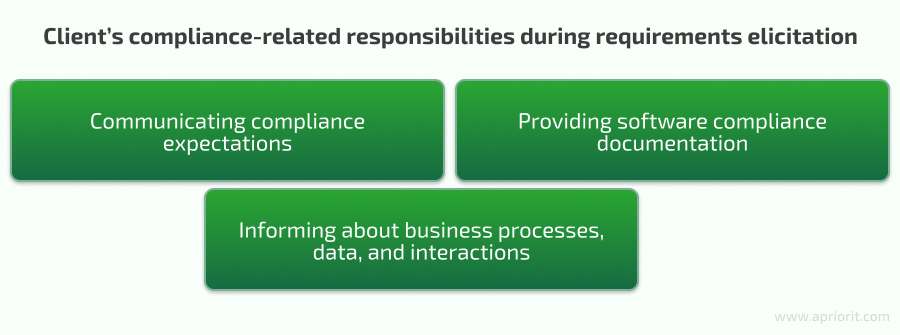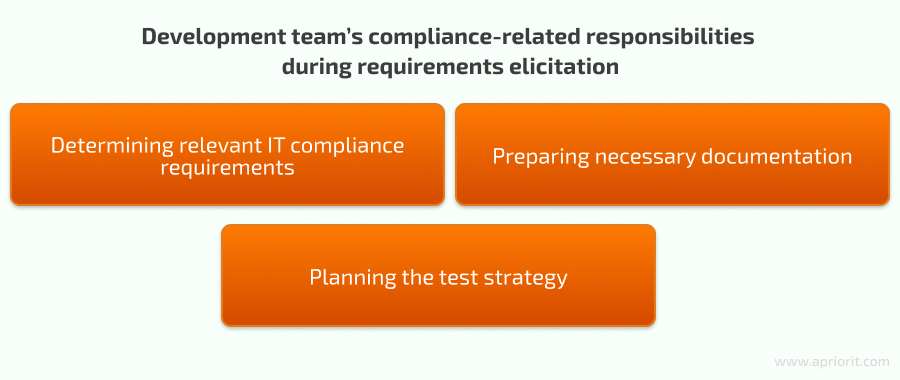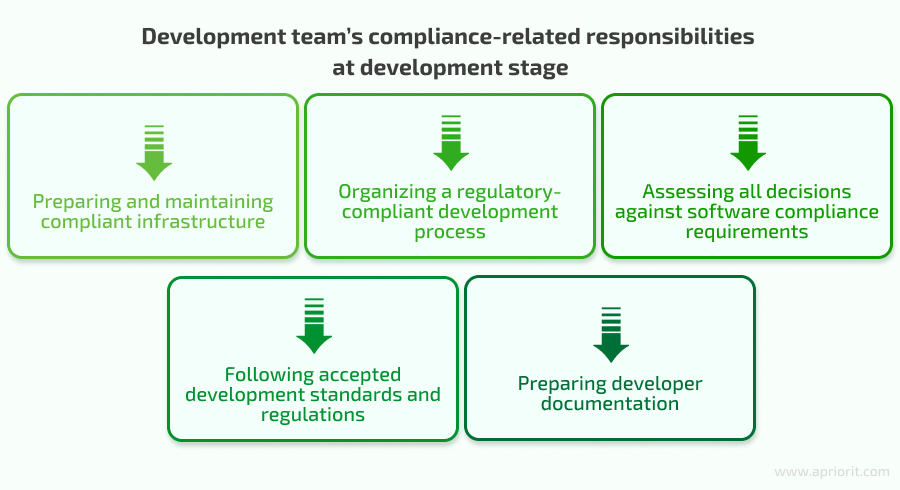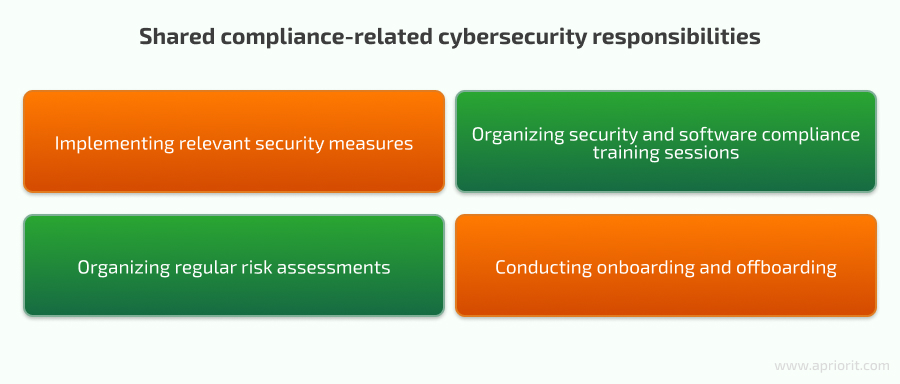Ensuring regulatory compliance is quite difficult even when you engage an experienced in-house development team. When you need to outsource some tasks, sharing compliance responsibilities can become an even bigger challenge.
In this article, we explore how you can share compliance responsibilities with an outsourced development team to deliver a secure product that meets all relevant requirements and what benefits you can get by outsourcing. We also show how you can ensure software compliance at every stage of the SDLC.
Contents:
The software development process can be split into several commonly recognized stages, from requirements elicitation to deployment and maintenance. Below, we discuss who’s responsible for what compliance-related activities at each stage. We also explore what actions you can take to ensure your product’s overall security.
The following separation of responsibilities showcases Apriorit’s approach to ensuring software compliance with local and industry-specific standards and regulations. In our descriptions, we’ll be using the term “team” or “development team” when talking about our areas of responsibility and “client” when describing yours.
Requirements elicitation
The most important thing during requirements elicitation is to define the laws, standards, and regulations your software should comply with and the certifications it has to pass. Once these are defined, you and your team can prepare a precise set of requirements to follow during software development.
At this stage, you and your development team should determine if it’s possible to comply with all necessary requirements. Performing a gap analysis allows you to identify what IT compliance requirements your product already meets and how to implement those it lacks.
The success of this stage depends on how efficiently you and your team cooperate to reach your goals. These are your key responsibilities at this stage:

- Communicating compliance expectations: If you know which IT compliance regulations apply to your product, you should share this information with your development team. It will help them plan the development process and save some time on research.
- Providing software compliance documentation: Some software compliance requirements are well-known and their documentation is easily accessed, such as HIPAA or the GDPR, while others might not be so common: for example, country-specific laws, new regulations like the Markets in Crypto Assets Regulation, or regulations that apply only in specific spheres of operation. In this case, it’s important to ensure that your team has all required documentation.
- Informing about business processes, data, and interactions: Understanding how your business works and who will use your product allows your team to make informed decisions during software development. For example, by knowing who will access your software on the business side and for what purpose, the team can suggest roles and permissions to ensure regulatory compliance.
Eliciting requirements involves a business analyst on the development team’s side. Thus, the activities listed below relate mostly to the BA’s area of responsibility.

- Determining relevant IT compliance requirements: Sometimes, software compliance documentation is quite large or not all requirements apply to your product. In this case, a business analyst determines all requirements the product must meet.
- Preparing necessary documentation: Once a business analyst defines the applicable software compliance requirements and discusses them with stakeholders, it’s important to document those requirements so that all team members have access to information about them. One common way to do this is with an IT compliance checklist. Your team probably already has checklists for most regular requirements and should be ready to prepare new checklists for niche ones.
- Planning the test strategy: With a list of defined requirements, the team can start planning the test strategy. A QA specialist defines a high-level approach to testing, outlines testing objectives, and selects testing types and tools to cover all software compliance requirements.
Eliciting requirements is the starting point in building a compliant product. Any misunderstandings here may lead to issues during the next stages. That’s why it’s important to closely communicate with your team at this stage before moving to architecture design.
Want to build secure and regulatory-compliant software?
A team of Apriorit experts is ready to assist you in delivering a product that will meet all relevant regulatory requirements.
Architecture design
Planning the product architecture is generally your development team’s responsibility. At this stage, an outsourced development team is usually responsible for:
- Selecting a technology stack and architectural design: This is an essential part of an architect’s work, as they need to make initial decisions that will become the foundation of the future product. For example, if software must protect personally identifiable information, an architect will select tools and technologies that support encryption and access protection.
- Addressing risks and participating in incident response procedures: If a project manager or developer detects software-related risks or potential breaches, a software architect assesses them and finds a way to minimize the damage.
During this stage, you and your development team may work together on security controls, access levels, and compliance monitoring.
Development
Before starting software development, we conduct special training sessions, share materials, and generally raise the development team’s awareness as to the regulatory requirements that must be met and the team’s areas of responsibility. Once all team members are familiar with the requirements, they should take them into account at every step of their work, ensuring that the final product is fully compliant.
Among the development team’s responsibilities at this stage are the following:

- Preparing and maintaining compliant infrastructure: Depending on the software compliance requirements, there are two main aspects to take into account: preventing unauthorized access and logging actions of authorized users. While developing and maintaining software, there may be a need to add new elements to the infrastructure or make new configurations. A DevOps engineer will control what is deployed, where, when, and by whom. At each step, the DevOps engineer ensures that the product remains in a secure, regulatory-compliant environment. This is especially important for complying with security standards and regulations such as NIST Special Publication 800-53, CIS Critical Security Controls, or the GDPR.
- Organizing a regulatory-compliant development process: Some compliance documents enforce strict requirements for how the development process is organized, such as stipulating specific types of documentation or reporting procedures. A project manager ensures that the team follows required procedures and creates full documentation, as this may need to be demonstrated to regulatory authorities during the compliance assessment process.
- Assessing all decisions against software compliance requirements: While developing a new feature, fixing an issue, or refactoring or improving a product, developers need to check that their decisions correspond to compliance requirements. By knowing the product’s internal structure, a developer can help mitigate risks, detect potential problems, and make the best decision for the product.
- Following accepted development standards and regulations: Some software compliance standards and regulations like System and Organization Controls 2 include strict requirements for the development process. Once these practices are outlined and defined, developers should follow them while implementing features.
- Preparing developer documentation: Documentation is an important part of ensuring software maintainability and preparing for a software compliance audit. All solutions must be documented so that the audit team can rely on the documentation.
Having outlined the main compliance-related activities for the development stage, let’s see what you and your team will need to take care of during product testing.
Testing
During testing, a QA team checks that the product complies with the necessary requirements. To arrange the testing process, QAs perform the following activities:
- Preparing test data sets: Since many software compliance requirements are aimed at protecting sensitive user data, QAs can’t use real user data for testing. At the same time, their data sets must be as realistic as possible and include an adequate amount of data. To resolve this issue, QAs may coordinate their data sets with experts on the client’s side to ensure that they’ve covered all corner cases and that data is plausible.
- Checking that all software compliance requirements are met: While testing, QA engineers check not only feature requirements but also whether a product fully meets software compliance requirements. Moreover, some software compliance standards, such as HIPAA, have a checklist that QA engineers can use to ensure that the product is in line with the requirements.
- Preparing test documentation and test results: It’s important to document all QA activities and test results, since many regulations require test documentation as part of the whole documentation package.
After outlining what activities you and your team need to perform to meet software compliance requirements at the testing stage, we can proceed to discussing the deployment stage.
Read also
HIPAA Compliance Checklist for Healthcare Software
Find out the main challenges of developing a HIPAA-compliant product and how to verify that your product corresponds with HIPAA requirements.
Deployment
Since the deployment process may be regulated by certain standards, special procedures are needed to provide evidence that the product was released in accordance with relevant compliance requirements. At this stage, an outsourcing development team is usually responsible for:
- Arranging a smooth deployment process: While deploying a product, the team needs to ensure network, infrastructure, and data security.
- Assisting in preparation for post-release certification and audits: Knowing all details of the deployed solution allows your development team to assist you in preparing for different certifications or audits.
Once a product is deployed, let’s find out the main activities to be performed at the maintenance stage and who is responsible for them.
Read also
Establishing Software Development Compliance: Challenges, Best Practices, and Requirements Overview
Explore how to determine relevant software compliance requirements and best practices to keep your product compliant.

Maintenance
While maintaining and updating the deployed product, it’s important to ensure that users’ personal data is not affected and that the product remains compliant with relevant standards and regulations. Ensuring product stability is a shared responsibility between you and your development team that requires the following activities:
- Monitoring and auditing: By monitoring vulnerabilities and changes in the environment, you can improve the product’s stability, while performing regular audits allows you to ensure that your product adheres to relevant software compliance requirements.
- Ensuring continuous improvement: Enhancing your product’s security, leveraging new technologies, and implementing new features on a continuous basis let you keep your product compliant with relevant standards and laws and meet your customers’ needs.
- Establishing incident response procedures: Properly developed procedures for responding to a potential incident can help you prevent or minimize possible damage as well as analyzing and correcting hazards to avoid such incidents in the future.
When properly implemented, these activities will help coordinate your and your outsourcer’s actions aimed at improving product security and ensuring compliance with IT requirements.
Security
Product security is also the main focus of many software compliance requirements. By implementing a secure SDLC at Apriorit, we add extra security measures at every stage of software development.
To protect sensitive data and build a regulatory-compliant product, a development team needs to be engaged in the following:

- Preparing an incident response plan: This plan defines roles and responsibilities and provides guidance on key activities during security incidents. Different development team members may take part in creating and validating a plan along with the security engineer.
- Monitoring employees: In some cases, the regulatory authority can require monitoring software to be installed on the machines of team members with access to sensitive information. There also might be a necessity to use Privileged Access Management solutions to regulate who can access certain resources and how. An information security specialist will help with both installing such solutions and educating your team about their importance.
In addition, you may share certain responsibilities with your development team:

- Implementing relevant security measures: Many software compliance standards focus on protecting sensitive data. For example, when working with credit card information, it’s important to comply with requirements of the Payment Card Industry Data Security Standard; when working with data of European Union residents, your software needs to meet GDPR requirements.
- Organizing security and software compliance training sessions: These training sessions are organized for both outsourcing development team and in-house development team members. An information security team has to study requirements to determine what training sessions should be held and how often.
- Organizing regular risk assessments: Regular risk assessment is part of many software compliance requirements. This activity helps the team timely react to constantly changing risks, discover potential vulnerabilities, and therefore increase end-users’ loyalty. While project managers assess and mitigate project risks, you may need to perform a product risk assessment on your end.
- Conducting onboarding and offboarding: You and your contractors must ensure that new team members are well-trained and have the exact level of access needed to perform their tasks. When someone leaves the project, an information security specialist should verify that no protocols have been violated and that all data and processes remain fully compliant with regulations.
Continually ensuring and strengthening product security at every stage of the SDLC is paramount for meeting most software compliance standards. Sharing responsibilities helps you and your team enhance product security and make better decisions.
Read also
Guide to Building GDPR Compliant Software: 5 Software Development and Testing Tips
Learn how the GDPR affects software development and what steps you should take towards building GDPR-compliant software.
How Apriorit can help you ensure software compliance
Outsourcing development of compliant software to a team with relevant expertise allows you to:
- Save time and resources of your team members, as you don’t need to grow internal expertise
- Get access to talents with relevant technical skills without a long hiring process
- Reduce the cost of setting up software infrastructure
Additionally, outsourcing allows you to scale teams quickly and efficiently according to your project and business needs.
Apriorit specialists have vast experience meeting well-known software compliance requirements stipulated by the GDPR, NIST, and PCI DSS as well as industry-specific requirements like HIPAA, TISAX, and ADA. We know how to tune our processes to comply with exclusive software compliance requirements.
By following key principles of a secure SDLC, we provide additional cybersecurity measures at every stage of the development process, from requirements elicitation to deployment.
Starting from the earliest project stages, we analyze software compliance to discover security and product compliance risks. While developing a product, Apriorit experts ensure data protection at the architectural level, perform penetration testing, and guarantee secure deployment.
Moreover, our engineers are ready to assist you in preparing for various audits and post-deployment certifications.
Conclusion
Building a product that complies with multiple IT standards, laws, and regulations is a complex multi-step process that requires the involvement of different specialists at all stages of development, from business analysts and project managers to software architects and QA specialists.
Defining who’s responsible for what and cooperating closely with your development team will help you properly assess and promptly mitigate project and product risks while improving product security.
For over 20 years, Apriorit has been helping tech companies worldwide create compliant products from scratch. Our dedicated team of software engineers, QAs, PMs, and BAs will help you deliver a product that fully complies with the requirements of local and industry-specific laws, regulations, and standards.
Looking for experts in developing compliant software?
Entrust your solution to Apriorit’s team of professionals.


